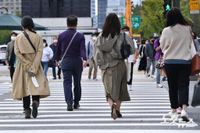South Korea's demographic trajectory has taken a concerning turn, as recent reports indicate a significant population decline on the horizon. According to the latest data from Statistics Korea, the total population of South Korea stood at approximately 51.75 million as of 2024. However, projections suggest that by the year 2072, the population is expected to plummet to around 36.22 million, marking a striking decrease of about 30% over the next 50 years. This decline represents roughly two-thirds of the population size seen today, raising alarm bells among policymakers and social scientists alike.
The report, titled ‘2024 Korea Social Index’ and released on March 25, 2025, sheds light on societal challenges that have emerged along with the demographic shifts. Particularly, it highlights the most acute social tensions experienced over the past year, which include polarized divisions between conservatives and progressives, growing disparities between the impoverished and the middle class, and conflicts that pit workers against employers. These issues have further intensified the socio-economic landscape in South Korea.
Current demographic statistics indicate that in 2024, children aged 0-14 account for approximately 10.6% of the total population, while those aged 15-64 make up 70.2%. The elderly population, aged 65 and above, constitutes 19.2%. However, the projections for 2072 suggest a dramatic shift, where the youngest age group will drop to 6.6%, while the older population will surge to 47.7%, indicating a reversal in population structure. This transition signals an impending situation where senior citizens outnumber those in their prime working years.
Statistics from 2023 reveal that the number of households in the country amounted to 22.73 million, an increase of 350,000 from the previous year. The proportion of household heads aged in their 50s accounts for the highest share at 22%, followed by 20% in their 60s and 18.8% in their 40s. It is particularly noteworthy that in recent years, the number of elderly households (those led by individuals aged 65 and over) has increased significantly—5.655 million in 2023, which is a staggering 3.3 times higher than in 2000.
Interestingly, while natural population growth remains a challenge, there is an observable rise in the number of long-term foreign residents. The 2023 statistics show that there are 1.882 million long-term stay foreigners, revealing a growing community that is partially compensating for South Korea's declining birth rate.
In terms of marriage trends, there is a positive note—2023 saw an increase in the number of marriages recorded, with a ratio of 4.4 marriages per 1,000 people, marking an increase of 0.6 compared to the previous year. Additionally, 52.5% of respondents believed that marriage was an essential part of life, reflecting a slight increase in societal attitudes towards family formation.
The total fertility rate, which indicates the average number of children a woman is expected to have during her reproductive years, has seen a slight uptick, recorded at 0.75 in 2024, an increase from the previous year. This translates to approximately 230,830 births, representing a gain of 8,300 from the year before. These trends mark the first increase in birth rates and total fertility since 2015 and may signal a modest turnaround in population dynamics.
Despite these signs of improvement, the challenges posed by an aging population cannot be overlooked. The expected life expectancy for babies born in 2023 is now 83.5 years, indicating an upward trend—an improvement from 76.0 years in 2000. The decreased gap in life expectancy between genders, now at 5.8 years, reflects some progress in health equity, although there remains a heavy toll from chronic illnesses. Cancer remains the leading cause of death in South Korea, with 166.7 per 100,000 people succumbing to malignancies, followed closely by heart disease and pneumonia.
Statistics reveal that the cancer incidence rate has risen to 1,953 cases per 100,000 individuals, while other chronic conditions such as hypertension, diabetes, and obesity are increasingly prevalent. Current lifestyles reflect rising smoking rates (18.5%) and drinking rates (55.1%), coupled with declining rates of regular physical activity (48.9%). These health challenges are compounded by alarming trends in diet, as noted by a decrease in the percentage of the population maintaining healthy eating habits, which fell to 49.2%.
Economic indicators provide a mixed picture. While nominal GDP reached 2,549 trillion won with a growth rate of 6.2% in 2024, the gap in income inequality remains a critical issue. The Gini coefficient stands at 0.323—showing a slight improvement from the previous year. However, the relative poverty rate remains unchanged at 14.9%, indicating persistent issues of social equity.
Moreover, the housing landscape appears to be stabilizing with a housing supply rate of 102.5% and an increase in the number of households meeting minimum housing standards. Despite these encouraging signs, rising rents in metropolitan regions and urban centers indicate that housing affordability remains a significant concern.
South Korea's major social divide persists, with reported conflicts primarily characterizing the relationship between conservatives and progressives (77.5%), followed by disparities between the impoverished and the middle class (74.8%) and labor conflicts (66.4%). Strikingly, as reported in the survey done just before the recent social upheaval, trust towards national institutions like local governments and the military remains relatively high, while trust in elections and political entities lingers at a low 26%.
In conclusion, South Korea finds itself at a critical juncture, facing demographic shifts that could redefine the nation's future. While there are encouraging trends in birth rates and increased foreign population, the pressing issues surrounding aging, health, and socio-economic divides raise substantial challenges that need immediate attention and comprehensive policy responses.





